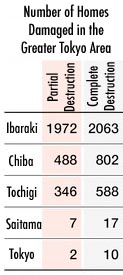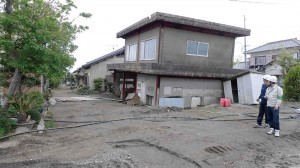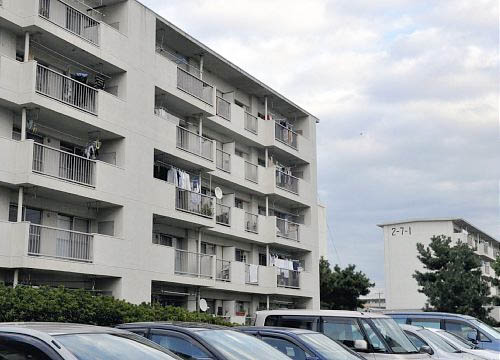Liquefaction in Sapporo caused by poor soil conditions

The September 2018 Hokkaido Iburi Earthquake resulted in severe liquefaction in part of Sapporo’s Kiyota Ward, leaving roads caved in and homes leaning at dangerous angles. As of October 3, as many as 1,452 homes had suffered damage in Kiyota Ward. This wasn’t the first instance for the neighborhood with liquefaction observed during the 2003 Hokkaido Earthquake which had an epicenter 300 kilometers away. The liquefaction hazard map issued by the city had previously designated this area as being of high risk for liquefaction damage.
3480 homes completely destroyed in Kanto area following Tohoku disaster
 An investigation by the Tokyo Shimbun has found that as many as 3480 homes in the Kanto area were completely destroyed in the Tohoku disaster. A further 2815 homes were partially destroyed and will need to be demolished. In some areas, the number of partially destroyed homes equalled the number that were completely destroyed.
An investigation by the Tokyo Shimbun has found that as many as 3480 homes in the Kanto area were completely destroyed in the Tohoku disaster. A further 2815 homes were partially destroyed and will need to be demolished. In some areas, the number of partially destroyed homes equalled the number that were completely destroyed.
Homeowners may be eligible to receive a maximum of 3 million Yen as compensation, but high construction costs mean that very few homes are being rebuilt. It has been almost 11 months since the disaster and the full extent of the damage is only now coming to the surface.Read more
Residents suing Mitsui over liquefaction damage
Approximately 32 residents from Urayasu City, Chiba, are suing Mitsui Fudosan for 700 million Yen after their townhouses were damaged by liquefaction during the Tohoku earthquake.Read more
New plan requiring land risks to be explained before sale
 The Japan Association of Home Suppliers has announced plans to require a site geography and history report to be presented to the buyer prior to the sale of a home.
The Japan Association of Home Suppliers has announced plans to require a site geography and history report to be presented to the buyer prior to the sale of a home.
There are approximately 100 home builders who are members of the Association. The committee chairman, also company president of Mita Housing, said that following the Tohoku disaster they had received an increasing number of inquiries from clients concerned about the liquefaction risk and strength of the ground. He believes that providing a geography and history report for each property would provide help to ease the concerns of buyers. Mita Housing is about to introduce this new reporting system into their own business, and many other real estate companies also have plans to do so.Read more
Danchi reconstruction cancelled due to liquefaction
 Reconstruction plans for the Sodegaura Danchi public housing project in Chiba's Narashino City have been put on hold as the recent liquefaction in the area caused by the March 11 Tohoku earthquake has deterred potential buyers for apartments in the new project.
Reconstruction plans for the Sodegaura Danchi public housing project in Chiba's Narashino City have been put on hold as the recent liquefaction in the area caused by the March 11 Tohoku earthquake has deterred potential buyers for apartments in the new project.
The Sodegaura Danchi was built in 1967 and has 250 units. It is built on reclaimed land on Tokyo Bay and is a 45 minute drive from central Tokyo. A 3-bedroom apartment in the complex can be rented for as low as 60,000 Yen/month (780 USD).Read more
Does your apartment building have earthquake insurance?
*If you own an apartment in Japan, you can take out optional earthquake insurance. This insurance only covers your apartment and does not cover the common areas of the building or the structure itself. The management association for the building can take out earthquake insurance on the common areas, but as it turns out, less than a third of all buildings are covered.
Owners of apartments in uninsured buildings are facing great repair bills as a result of the March 11 Tohoku Earthquake.Read more
Which areas are at risk of liquefaction in an earthquake?

During the March 11 earthquake, some areas along the bay area in Tokyo suffered damage from liquefaction. The above images are from Toyosu and Shinonome in Koto-ku.
Between 1881 and 1930 the following reclaimed land was created:
- Tsukishima 1~4 Chome
- Minato-ku's coastal area (Shibaura 1~4 Chome, Kaigan 1~4 Chome)
- Shiomi area in Koto-ku
- Toyosu
- Edagawa, Koto-ku
- Tennozu Isle, Shinagawa-ku
Below is a map showing the reclaimed land in Tokyo Bay up until 2002. A total area of 17,580,000 Tsubo (58 million sqm) of land was reclaimed between the 1860s and 2002.Read more
